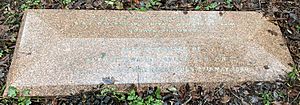Alfred Swaine Taylor facts for kids
Quick facts for kids
Alfred Swaine Taylor
|
|
|---|---|
 |
|
| Born | 11 December 1806 Northfleet, Kent, UK
|
| Died | 27 May 1880 (aged 73) London, England
|
| Burial place | Highgate Cemetery |
| Occupation | Toxicologist, Surgeon, Chemist, Forensic Scientist, Expert witness, Author |
| Years active | 1831-1870 |
| Spouse(s) |
Caroline Cancellor
(m. 1834; died 1876) |
| Children | 2 |
Alfred Swaine Taylor (born December 11, 1806, in Northfleet, Kent; died May 27, 1880, in London) was a very important English doctor and writer. He is often called the "father of British forensic medicine". This means he helped start the use of science to solve crimes in Britain. He was also one of the first people to experiment with photography.
Contents
Who Was Alfred Swaine Taylor?
Alfred Swaine Taylor was a toxicologist, which is a scientist who studies poisons. He was also a surgeon (a doctor who performs operations) and a chemist (a scientist who studies chemicals). His work in forensic medicine meant he used his scientific knowledge to help courts understand how crimes happened.
Taylor's Early Life and Education
Alfred Swaine Taylor began his medical studies at Guy's Hospital and St Thomas's Hospital in London. These were two very famous hospitals. He worked hard to learn about the human body and how it works.
A Pioneer in Forensic Science
In 1831, Taylor became a teacher at Guy's Hospital. He taught a subject called medical jurisprudence. This field combines medicine and law. It helps legal cases by using medical facts.
Taylor wrote many important books about medical jurisprudence and toxicology. These books helped other doctors and lawyers learn about these new fields. He also wrote for medical magazines. He even edited a magazine called the Medical Gazette.
Taylor often appeared in court as an expert witness. This meant he used his scientific knowledge to explain medical facts to judges and juries. He helped solve many important cases.
Contributions to Photography
Besides his medical work, Taylor was also interested in photography. He helped develop a way to "fix" photographs. This process used a chemical called hyposulphate of lime. It made sure the pictures would not fade away quickly. This was a big step forward for early photography.
Where Is He Buried?
Alfred Swaine Taylor is buried in Highgate Cemetery in London. This is a famous cemetery where many important people are buried.
Taylor's Important Books
Alfred Swaine Taylor wrote many books that were very important for his time. These books helped shape the fields of forensic medicine and toxicology. Some of his well-known works include:
- On the Art of Photogenic Drawing, 1840 (about early photography)
- Manual of Medical Jurisprudence, 1844 (a guide to medical law)
- On poisons in relation to medical jurisprudence and medicine, 1848 (about poisons and their effects)
- The principles and practice of medical jurisprudence, 1865 (another key book on medical law)


